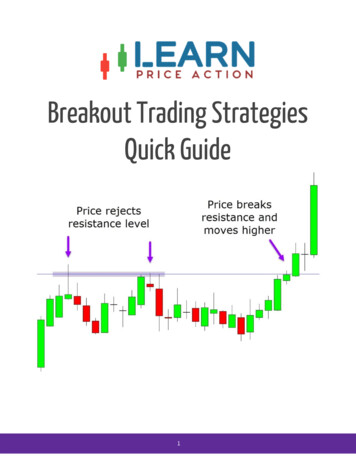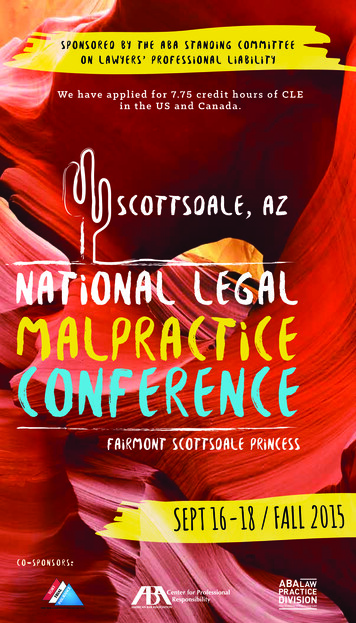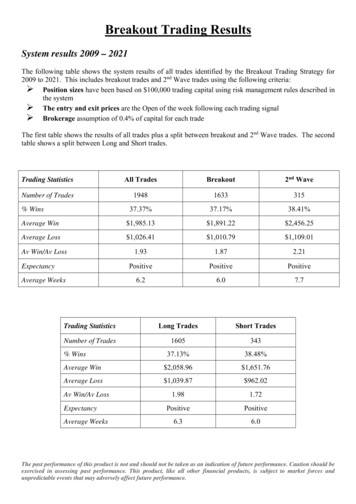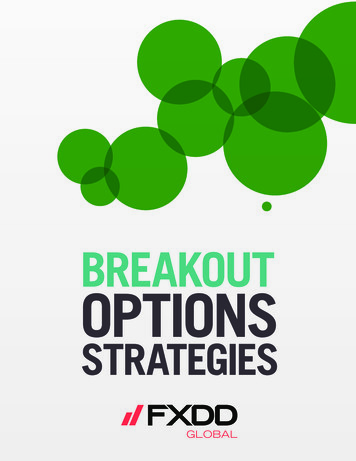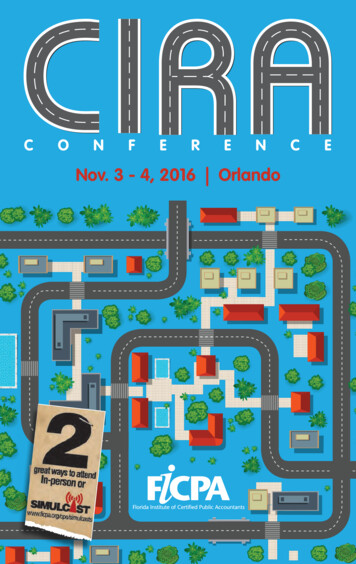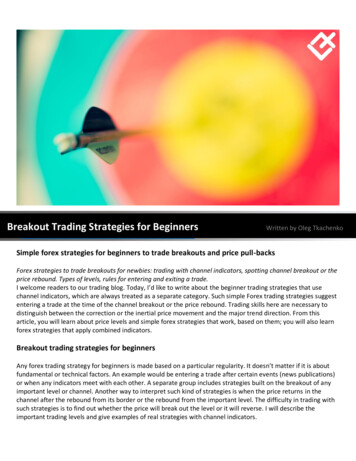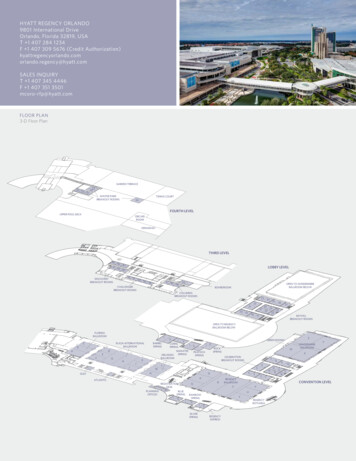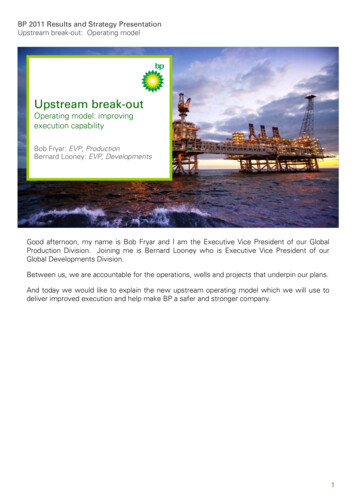
Transcription
BP 2011 Results and Strategy PresentationUpstream break-out: Operating modelUpstream break-outOperating model: improvingexecution capabilityBob Fryar: EVP, ProductionBernard Looney: EVP, Developments1Good afternoon, my name is Bob Fryar and I am the Executive Vice President of our GlobalProduction Division. Joining me is Bernard Looney who is Executive Vice President of ourGlobal Developments Division.Between us, we are accountable for the operations, wells and projects that underpin our plans.And today we would like to explain the new upstream operating model which we will use todeliver improved execution and help make BP a safer and stronger company.1
BP 2011 Results and Strategy PresentationUpstream break-out: Operating modelCautionary statementForward-looking statements - cautionary statementThis presentation and the associated slides and discussion contain forward-looking statements, particularly those regarding: expected increases in investment in exploration and upstreamdrilling and production; anticipated improvements and increases, and sources and timing thereof, in pre-tax returns, operating cash flow and margins, including generating around 50% moreannually in operating cashflow by 2014 versus 2011 at US 100/bbl; divestment plans, including the anticipated timing for completion of and final proceeds from the disposition of certain BPassets; the expected level of planned turnarounds and related production outages; expectations of a challenging marketing environment in 2012, particularly in respect of petrochemicals; theexpected increase in exploration activity; expectations for drilling and rig activity generally and specifically in the Gulf of Mexico; plans to improve reservoir management and plant reliability; thelevel of performance improvement in Refining and Marketing; expected full-year 2012 organic capital expenditure and increased capital spend for the future; the expected timing and level offinal investment decisions; the expected duration of production at Mad Dog the timing and composition of major projects including expected start up, completion, level of production andmargins; the expected timing and level of appraisal activity; plans to acquire seismic surveys for exploration, field development and reservoir management; the timing for completion of theWhiting refinery upgrade, other refining upgrades and logistics optimization; the expected level of production in the first quarter of 2012 and in full-year 2012; plans to continue to seekopportunities and prospects in BP’s areas of strength, such as deepwater, gas value chains and giant fields; plans to strengthen BP’s position in unconventionals; the expected productionpotential of certain existing unconventional oil assets; expectations about BP’s development of new technology; the timing of the deployment of BP’s new single work management system;the sources and timing of volume growth and earnings momentum in Lubricants and Petrochemicals; expected future levels of resource recovery in giant fields; expansion plans, includingplans to expand petrochemicals operations in China; and plans to create a new revenue stream through licensing certain technology. By their nature, forward-looking statements involve riskand uncertainty because they relate to events and depend on circumstances that will or may occur in the future. Actual results may differ from those expressed in such statements, dependingon a variety of factors including the timing of bringing new fields onstream; future levels of industry product supply; demand and pricing; OPEC quota restrictions; PSA effects; operationalproblems; general economic conditions; political stability and economic growth in relevant areas of the world; changes in laws and governmental regulations; changes in taxation or regulation;regulatory or legal actions including the types of enforcement action pursued and the nature of remedies sought; the actions of prosecutors, regulatory authorities, the Gulf Coast Claims Facilityand the courts; the actions of all parties to the Deepwater Horizon oil spill-related litigation at various phases of the litigation; exchange rate fluctuations; development and use of newtechnology; the success or otherwise of partnering; the successful completion of certain disposals; the actions of competitors, trading partners, creditors, rating agencies and others; naturaldisasters and adverse weather conditions; changes in public expectations and other changes to business conditions; wars and acts of terrorism or sabotage; and other factors discussed under“Risk factors” in our Annual Report and Form 20-F 2010 as filed with the US Securities and Exchange Commission (SEC).Reconciliations to GAAP - This presentation also contains financial information which is not presented in accordance with generally accepted accounting principles (GAAP). A quantitativereconciliation of this information to the most directly comparable financial measure calculated and presented in accordance with GAAP can be found on our website at www.bp.com.Statement of Assumptions - The operating cash flow projection for 2014 stated on slides 8, 10, 11, 33, 38, 58, 61, 62 and 63 of the 2011 Results and Strategy Presentation reflects ourexpectation that all required payments into the 20 billion US Trust Fund will have been completed prior to 2014. The projection does not reflect any cash flows relating to other liabilities,contingent liabilities, settlements or contingent assets arising from the Deepwater Horizon incident which may or may not arise at that time. As disclosed in the Stock ExchangeAnnouncement, we are not today able to reliably estimate the amount or timing of a number of contingent liabilities.Cautionary note to US investors - We use certain terms in this presentation, such as “resources”, “non-proved resources” and references to projections in relation to such that the SEC’s rulesprohibit us from including in our filings with the SEC. U.S. investors are urged to consider closely the disclosures in our Form 20-F, SEC File No. 1-06262. This form is available on our website atwww.bp.com. You can also obtain this form from the SEC by calling 1-800-SEC-0330 or by logging on to their website at www.sec.gov. Tables and projections in this presentation are BPprojections unless otherwise stated.February 201222
BP 2011 Results and Strategy PresentationUpstream break-out: Operating modelNew operating model now in placeRelentless focus on safety and managing riskOrganization in place and aligned with delivery Exploration: Access, Exploration and Appraisal Production: Subsurface, Operations Developments: Global Projects Organization, Global Wells OrganizationReducing complexity – stronger and more focusedGlobal standards in place and driving Risk reduction Systematic, consistent execution Increased reliability Cost and investment efficiency3The principle is to simplify and standardize the way we operate, focusing our efforts on safetyand value.The new organization is already working well with benefits in both safety and performance.Much of this is being achieved by mandating what and how things get done on a global level.As part of this, we are bringing great clarity to how our organization aligns toward performancedelivery – such as Subsurface, Wells and Operations working end to end in delivery of our newwells.From top to bottom of the organization, our staff are focused on reducing risk using deeptechnical rigor in everything we do to systematically improve execution leading to short termcash and long term value.We’ll start by looking at risk reduction across the segment and then we want to explain howthese factors are being implemented in four areas - Subsurface, Operations, Major Projectsand Wells.3
BP 2011 Results and Strategy PresentationUpstream break-out: Operating modelRisk reductionOperations Management System (OMS) Mandatory systematic requirement for our globaloperations Standardization of practices and procedures Risk identification and systematic mitigation atfront lineInvesting in integrity Continued turnaround program Enhanced maintenance standardsVoluntary performance standards Beyond existing regulatory obligations Applies lessons learned from Deepwater HorizonVoluntary PerformanceStandards Deepwater, dynamicpositioned, subseablowout preventers(BOPs) equipped withno fewer than twoblind shear rams anda casing shear ram Third party verificationof testing andmaintenance ofsubsea BOPs Enhanced conduct/witnessing of laboratorytesting of cement slurries for deepwaterprimary cementing in exposed zonesCapability Recruitment and renewal4We believe that a good company manages risk well.We are embedding our new operating model, we have been taking very practical steps to putsafety at the heart of our company - structurally, via the processes we use, and personally,through the values we expect our leaders and staff to convey at all times.At the centre of this is our mandated Operating Management System, or OMS. OMS sets outthe standards we are bound by and the common way we operate around the world. OMS isdesigned to do two things, drive down risk and systematically improve the quality of ouroperations. Included in this is transparency of the risks and what we do to mitigate them – soeveryone understands the risks and the mitigation actions – from the front line all the way toBob Dudley.The number one objective of any oil and gas operation is to maintain the integrity of itsinfrastructure from reservoir to market – always maintaining control of its product. We havemade significant progress in 2011. For example, across our upstream portfolio we achieved a22% reduction versus 2010 in loss of primary containment.We have also completed many integrity and equipment upgrades via our extensivemaintenance and turnaround program.We believe that in some cases our standards should be higher than those set out by hostgovernment regulations or common industry practices. Given what we have learned fromDeepwater Horizon, this is particularly relevant to drilling. We have set out a number ofinternal standards that are making us safer and stronger – this is good business.As a priority, we are investing heavily in the capability of our people. In 2011, we hired over2,000 technical people, bringing in specialized skills and renewing our organization for the longterm.4
BP 2011 Results and Strategy PresentationUpstream break-out: Operating modelSubsurface: maximize value from reservoirsReservoir management Maximize production from reservoirs Increase recovery factorLeverage global scale Programme managementBright WaterTMtechnologyMore than 70 treatments inAlaska, Argentina andAzerbaijan. Improvingwaterflood sweep andrecovery by 20 mmboe Focus resources on highest value TechnologyGreater Plutonio4D seismic and state of theart Field of the Future surveillance tools used togenerate 25 additional welltargets and optimizeproductionBright WaterTM is a trademark of NalcoField of the Future is a registered trademark of BP5Let’s now look at our global subsurface organization which is part of the Production Divisionand comprised of over 1,800 scientists and engineers. They are accountable for the day to daymanagement of our reservoirs – optimizing production and progressing our resources tomaximize recovery. With our new operating model, we now have clear line of sight to howreservoirs are performing. We are driving consistent technical practices and have developedcentres of expertise that we can deploy to areas of greatest value.The majority of our top assets are waterflooded oil reservoirs in world class basins. A higherproportion of BP’s major assets are developed with waterflood than other major IOCs whichgives us a distinctive capability. Optimizing recovery from giant field waterfloods requiresoperating experience at scale, advanced surveillance techniques and the application of highend technology.Seismic imaging is increasingly important to subsurface description and prediction. We areinvesting to maintain the leadership position that we achieved through step changes such asour wide azimuth seismic technology for subsalt imaging and simultaneous source technologyfor onshore seismic. Globally, we will continue to acquire between twenty to twenty-fiveseismic surveys annually for exploration, field development and reservoir management. Ourhigh performance computing centre in Houston used for seismic processing ranks amongsome of the highest capacity supercomputers in the world.5
BP 2011 Results and Strategy PresentationUpstream break-out: Operating modelOur Subsurface technology flagship programmes continue to improve recovery performance.For example, we are now deploying more than 20 Bright Water treatments per year whichaccounts for the vast majority of industry activity. Bright Water is a heat activated polymer thatblocks water swept zones deep in the reservoir to improve sweep efficiency and increase oilproduction. We expect to produce over 20 million barrels at less than 6 per barrel fromtreatments to date. We have over 60 scientists dedicated to further developing recoverytechnology to manage the performance of our reservoirs.We are already pushing the boundaries of reservoir management through our Field of theFuture programme, using real time information from our wells. For example, in GreaterPlutonio in Angola, every well is monitored continuously by our subsurface staff. We achieved129 pressure build up surveys in 2011, giving us vital information on how our reservoirs areperforming. This, coupled with 4D seismic imaging, has unlocked 25 additional well targets inthat field alone.On the basis of these technologies and capabilities, we believe reservoir management andresource progression remain key points of differentiation for BP.6
BP 2011 Results and Strategy PresentationUpstream break-out: Operating modelOperations: driving increased reliabilityReliability improvements Turnarounds Defect elimination Dedicated reliability driven projectsLeverage global scaleTangguh LNGFollowing a defectelimination program, facilityuptime 95% enablingmore cargo shipments tosell into higher valuemarkets Common standards and practices Global standard systemsGreater Plutonio Investing in capabilityFollowing a turnaround in2011, facility uptime isaveraging 93%7Moving on to operations: safe, compliant and reliable facility operations represent a big driverof overall Upstream delivery. And this is where our Global Operations team comes in. Its job isto optimize facilities and to process and transport our production to market safely and reliably.To achieve this, we are focusing our efforts on delivering turnarounds – or TARs – to eliminatedefects and drive improvements. We have mandated and implemented a common globalprocess for planning and executing TARs which has markedly improved on-time TAR delivery.Facility turnarounds are a centrepiece of our maintenance programme as they represent theonly time a facility is fully shut down and depressurized, allowing for major repairs,improvements and tie-in of new infrastructure. We completed 47 TARs in 2011, a historicallyhigh number. Looking forward, we have another large program of 37 TARs planned for 2012.We expect overall production outages to be lower in 2012 than 2011.The benefits of our TAR and defect elimination programmes are already being seen around theworld. For example, in Tangguh in Indonesia, following a dedicated defect elimination programand TARs in 2011, facility uptime has increased to more than 95%. This has enabled morecargo shipments, with more going to higher value markets allowing for a material increase inrealized gas prices. In Angola, after a successful execution of a TAR in Greater Plutonio in thesummer of 2011, planned efficiency is averaging 93%.7
BP 2011 Results and Strategy PresentationUpstream break-out: Operating modelWe have also been investing in our processes, systems and people. To support this, we aredeploying a single global work management system, or digital backbone, incorporatingmaintenance and procurement. We have already deployed this in a series of pilot locations andexpect to have it embedded in most of our operations by 2014.A key to all of this is our investment in capability. In 2011, we hired around 1,000 people intoour operations organization. This was coupled with a global organizational model to assure wehave the right skills in the right places. As part of this we have brought in external executiveexpertise such as our global heads of maintenance and logistics.I would now like to hand over to Bernard who will take us through the operating model and keyactivities for our Developments Division.8
BP 2011 Results and Strategy PresentationUpstream break-out: Operating modelGlobal Projects Organization: improving execution qualityBuilding world class capability Increased BP staff by 25% Building technical capabilityImproving Front End Loading (FEL) New FEL standards tied to external benchmarks New projects achieving “Best in Class”Improved predictability Major Projects Common Process Global Project Organization working under OMS On-time start-up and cost delivery has improvedLeverage global scale Created subsea hardware organization Centralized contracting with 21 global agreementsStandardization:SubseaChristmas Trees Historically managed 20 designs Standard specifications utilizing twocontractors to support– 14 major developments witharound 200 Trees– 5bn gross investment Results– Pre-engineered options– Predictable delivery– Ease of manufacturing– Improved reliability– Ease of troubleshooting9Thank you Bob. Good afternoon. I would like to update you on the progress we’ve made inimproving the execution of our global projects and global wells operations. Let’s start withProjects.Global Projects Organization: improving execution qualityWe now have a single Global Projects Organization working under our common OperatingManagement System. The journey began in 2005 with the implementation of our MajorProjects Common Process. But it was really accelerated in 2010 with the creation of our GlobalProjects Organization – one team accountable for delivery of our projects worldwide.We are beginning to see some results and I would like to share four examples.Firstly, we are building world class Capability. In 2011, we increased the number of BP staffby 25% through a major recruitment program to build expertise in key focus areas. One sucharea is Quality Management. We hired an expert from the Aerospace industry with deep skillsin this discipline. He is growing our team, developing improved standards and working with oursuppliers to eliminate defects. Getting Quality right will materially improve our delivery.Secondly, we are improving our Project Front End Loading. We believe that better Front EndLoading leads to better projects. In 2011, we implemented new rigorous standards to driveimprovement in this area. The last eight major projects we approved all achieved ‘best inclass’ Front End Loading as measured by external benchmarks. This sets us up well forexecution.Thirdly, we are improving the Predictability with which we deliver our Projects.Over the last four years, we have improved our cost delivery by 25% and our schedule deliveryby 35% – when compared to our original FID targets.9
BP 2011 Results and Strategy PresentationUpstream break-out: Operating modelAnd Fourthly, we are leveraging our global scale to deliver value.A great example, and one I believe is leading the industry, is the creation of a single globalsubsea hardware organization for the design and procurement of all of our subsea equipment.This has enabled us to standardize designs, work processes and procedures and leverage ourscale in the supply chain through establishing global agreements with our two key suppliers.This is improving quality and predictability as well as reducing costs by around 15%. Over thenext five years we expect to spend over 5 billion gross on subsea hardware.We now have 21 Global Agreements in place covering a large proportion of our activity –engineering services, rotating equipment, automation, valves, etc. They will all help deliverstandardization, improved quality and reliability.As you can see we have taken deliberate steps over the past few years to deepen our projectscapability. There remains more to do, we are beginning to see real evidence of performanceimprovement. Lets look now at where this new organisation is being applied.10
BP 2011 Results and Strategy PresentationUpstream break-out: Operating modelMajor projects underpin operating cash flow growthDeepwaterWI%(2)Block 31PSVM(1)27150 mboedClochasMavacola27100 mboedStart-up Project20122013 /2014(1)GasGrossCapacityProjectAngola LNGGiant 00 mmscfdSkarv(1)24165 mboedDevenick(1)89200 mmscfdKinnoull(1)7750 mboedGalapagos(1) 47-6760 mboedNa KikaPhase 3(1)5040 mboedNorth Rankin 2171,800 mmscfdCLOV17160 mboedIn SalahSouthern Fields33420 mmscfdChirag Oil(1)36140 mboedMars B29130 mboedIn AmenasCompression46330 mmscfdSunrise5060 mboedBP operated2)11Working InterestWe have a world class Major Projects portfolio and are on track to deliver 15 start-ups by theend of 2014. These projects will have on average around twice the 2011 Segment unitoperating cash margin. Six of these projects are on track to start up this year.Let me give a brief update on a couple of larger projects that will start up this year.The PSVM project in deepwater Angola is a complex 48 well subsea development utilizing anFPSO for production, storage, and offloading of oil. The project ties in four fields (Plutao,Saturno, Venus and Marte) into a single infrastructure development. At this time, the FPSO ison its voyage from Singapore to Angola and it is expected to arrive by the end of the month.The FPSO sailed after completing 96% of commissioning onshore which is an exceptionallevel of readiness.As you have heard from Bob we recently FID’d Mad Dog 2, our largest operated greenfieldproject in the Gulf of Mexico in almost 10 years. We have start ups in the Gulf of Mexico inthe short term as well. As an example, Galapagos is a 3 well subsea tieback to the Na Kikaplatform. The wells have been drilled and the subsea scope is largely complete. Topsides tiein work on the platform is progressing to plan and we expect to bring the project online laterthis year.Turning now to Drilling – what we call “Wells”.11
BP 2011 Results and Strategy PresentationUpstream break-out: Operating modelGlobal Wells Organization: improving execution qualityFocus on Safety and Operational Risk Global Wells Organization working under OMS Closing out Bly Report Global Rig Acceptance and Start-up ProceduresBuilding world class capability Increased BP staff over 20% Building technical capability Creating Global Wells Institute for learningIncreasing Activity Integrated Global Rig Schedule Activity increasing in 2012 and beyond – focused on highmargin areas12Our new Global Wells Organization, put in place in April last year, has begun a similar journeyto that in Projects. This one organisation is solely accountable for the delivery of all drillingworldwide. We plan to replicate the improving execution performance and predictabilityexperienced in Projects – and there are already tangible signs of progress.Firstly, we have a relentless focus on Safety and Operational Risk – and strongly believe thiswill drive enduring value for our shareholders. The new organization is in place and transitioningto our single operating management system. We are on track to close out actions from thefindings of BP’s investigation into the Deepwater Horizon accident. And we are establishingstricter standards for safe and compliant wells as well as changing the way we work with keycontractorsAn early example of this is our application of a new Global Rig Acceptance and Start-upprocedure. This ensures that no rig will commence operation until we are sure that it willoperate to our standards. Investment in this up front will reduce risk and improve efficiency.Secondly, we are building world class capability – creating and sustaining talent to ensure thelong term health of our business. In 2011, we increased the number of BP staff by over 20%through a major global recruitment program. This isn’t just about numbers – it is about bringingin key technical skills like cementing, well control and rig audit. And beyond recruiting, we areinvesting in learning and the development of all our people through the creation of a GlobalWells Institute which will include virtual learning centres in many of our locations.12
BP 2011 Results and Strategy PresentationUpstream break-out: Operating modelFinally, all of the above gives us the confidence to increase activity. Our new integrated globalrig schedule process allows us to understand which drilling operations really make a differenceand ensures that the right people and resources are allocated to them. Much of this is focusedon our higher margin areas, for example: In Angola – where we plan to increase the rig fleet in our operated fields to three deepwaterrigs by the end of this year In the Gulf of Mexico - where we have five rigs working with a further three planned to startup this year And in Azerbaijan - where we plan to add two rigs this year.So all in all - much still to do, but significant progress in building a strong foundation for thedelivery of safe and compliant wells.13
BP 2011 Results and Strategy PresentationUpstream break-out: Operating modelMoving ForwardFocus on Safety and Operational RiskOperations and Subsurface Reservoir management Reliability and defect elimination TurnaroundsMajor Projects 15 major project start-ups by 2014, 6 in 2012 By 2014, unit operating cash margin from new projects is expected to bedouble the 2011 upstream average (excl. TNK-BP)(1)New Wells Building strong foundations through the Global Wells Organization Increasing high value activity around the world(1)14At 100/bbl oil priceSo, in summary we have provided you an overview of our new operating model and how weexpect that model to fundamentally improve how we execute our activities. The model isalready working well and we are seeing many benefits as we have explained.Looking forward, delivery through 2014 is underpinned by the following:1.Continued relentless focus on Safety and Operational Risk – this is simply the right thingto do2.Improving reservoir management and plant reliability3.Improving execution on a strong portfolio of Major Projects that materially improvesmargin capture in the Upstream4.And delivering our wells activity plan through our new Global Wells OrganizationWe firmly believe the new operating model has created a simpler and more focused Upstream.It is one that will relentlessly drive down risk, better leverage our scale and deliver a globallyoptimized activity set - geared toward long term value.So thank you very much for your time - and now Bob and I would be delighted to take any ofyour questions.14
BP 2011 Results and Strategy Presentation Upstream break-out: Operating model 1 Upstream break-out Operating model: improving execution capability Bob Fryar: EVP, Production Bernard Looney: EVP, Developments Good afternoon, my name is Bob Fryar and I am the Executive Vice President of our Global Production Division. Joining me is Bernard Looney .
